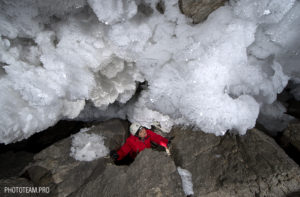 Some caves become a natural cold storage. The cold is accumulated due a special form of the cavities where a special air circulation is created.
Some caves become a natural cold storage. The cold is accumulated due a special form of the cavities where a special air circulation is created.
A cold settled in a cave changes everything. Cave fauna and flora should adapt to the cold and only the most cold-resistant species stay live in the cave. In the summer, different animals come to the entrance searching for the cool and water. Ice Cave can even change the climate locally: due to cold plants develop slowly, sometimes near the entrance not typical for the region as a whole, more cold-resistant flora can be found.
Ice also may affect the geological development of a cave. It may fill a cavity and slow down its development, or on the contrary, freeze in cracks, expand and accelerate the karst processes.
its development, or on the contrary, freeze in cracks, expand and accelerate the karst processes.
One may get an impression that this kingdom of ice is detached from the outside world, but in fact it is a sensitive instrument that records climate changes in the thickness of the cave ice. As a new ring grows in the depth of a tree every year, so there is a new layer, which appears in the thickness of the cave glacier every year. The thickness of the ice layers, their transparency and granularity say how long were periods of cooling and warming in the cave, and hence on the surface. If we know the patterns of distribution of temperature in the cave, we will be able to decrypt the information recorded in the ice thickness: it will tell how climate changed over hundreds and thousands of years.
 In order to complete this National Geographic assignment, PHOTOTEAM.PRO visited dozens of Ural caves and choosed the most impressive and characteristic.
In order to complete this National Geographic assignment, PHOTOTEAM.PRO visited dozens of Ural caves and choosed the most impressive and characteristic.
To see more photos from the project, please, click here
As a part of the project, a spherical panorama has been created
